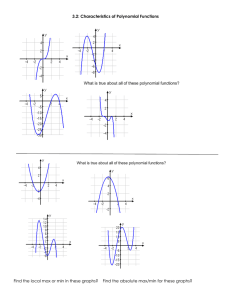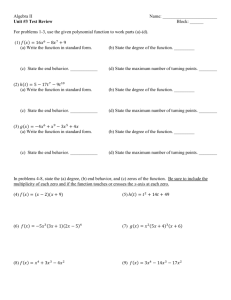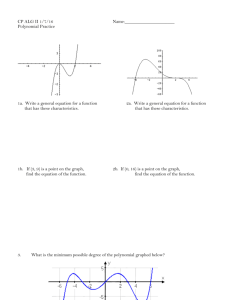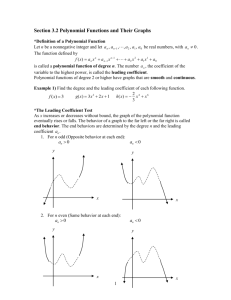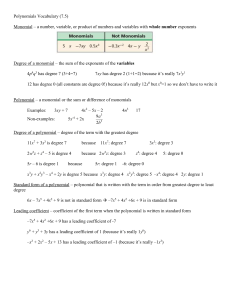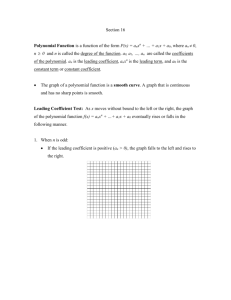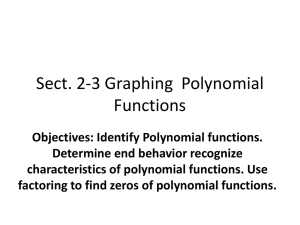Section 2.3
advertisement
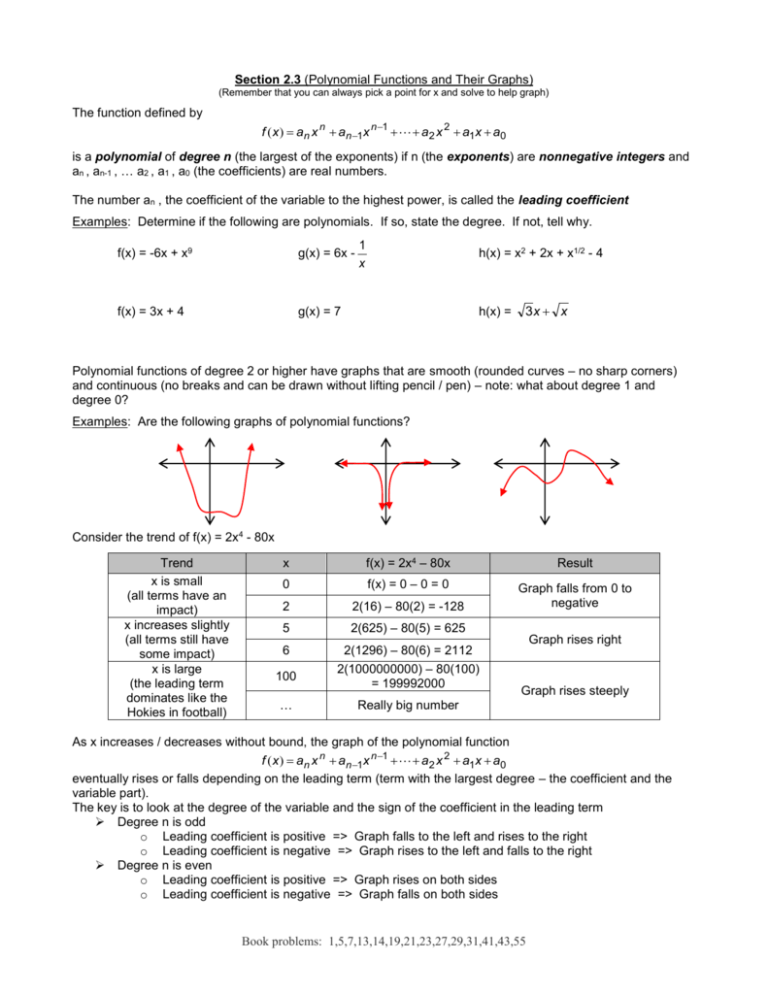
Section 2.3 (Polynomial Functions and Their Graphs) (Remember that you can always pick a point for x and solve to help graph) The function defined by f ( x ) an x n an 1x n 1 a2 x 2 a1x a0 is a polynomial of degree n (the largest of the exponents) if n (the exponents) are nonnegative integers and an , an-1 , … a2 , a1 , a0 (the coefficients) are real numbers. The number an , the coefficient of the variable to the highest power, is called the leading coefficient Examples: Determine if the following are polynomials. If so, state the degree. If not, tell why. f(x) = -6x + x9 g(x) = 6x - f(x) = 3x + 4 g(x) = 7 1 x h(x) = x2 + 2x + x1/2 - 4 h(x) = 3x x Polynomial functions of degree 2 or higher have graphs that are smooth (rounded curves – no sharp corners) and continuous (no breaks and can be drawn without lifting pencil / pen) – note: what about degree 1 and degree 0? Examples: Are the following graphs of polynomial functions? Consider the trend of f(x) = 2x4 - 80x Trend x is small (all terms have an impact) x increases slightly (all terms still have some impact) x is large (the leading term dominates like the Hokies in football) x f(x) = 2x4 – 80x 0 f(x) = 0 – 0 = 0 2 2(16) – 80(2) = -128 5 2(625) – 80(5) = 625 6 2(1296) – 80(6) = 2112 100 2(1000000000) – 80(100) = 199992000 … Really big number Result Graph falls from 0 to negative Graph rises right Graph rises steeply As x increases / decreases without bound, the graph of the polynomial function f ( x ) an x n an 1x n 1 a2 x 2 a1x a0 eventually rises or falls depending on the leading term (term with the largest degree – the coefficient and the variable part). The key is to look at the degree of the variable and the sign of the coefficient in the leading term Degree n is odd o Leading coefficient is positive => Graph falls to the left and rises to the right o Leading coefficient is negative => Graph rises to the left and falls to the right Degree n is even o Leading coefficient is positive => Graph rises on both sides o Leading coefficient is negative => Graph falls on both sides Book problems: 1,5,7,13,14,19,21,23,27,29,31,41,43,55 Examples: Look at the chart on page 304 and use the Leading Coefficient Test to determine the end behavior of the graph of the following f(x) = 3x7 – 2x5 – 4x2 + 6 g(x) = 8x6 + 4x5 + 8 h(x) = -4x4 + 3 The values of x for which the polynomial function f(x) is equal to 0 are called the zeros of f (also called the roots or solutions of f). Each real root is an x-intercept of the graph of the polynomial function. Example: Find all zeros of… f(x) = x3 + 2x2 – 4x – 8 g(x) = x4 – 4x2 In the 2nd example just shown, the factorization was g(x) = x2(x + 2)(x – 2). The factor x occurs twice and the factors (x + 2) and (x – 2) occur once. The number of times a factor occurs gives the multiplicity of that zero. So our solution 0 has multiplicity 2 and our solutions 2 and -2 have multiplicity 1. If a zero (solution) has even multiplicity, the graph touches the x-axis at this point and turns around. If a zero (solution) has odd multiplicity, the graph crosses the x-axis at this point. Example: Find the zeros / the multiplicity of each zero, and state the behavior of the graph at each zero g(x) = x4 – 4x2 f(x) = -4(x + ½)2(x – 5)3 You can use the facts learned in this section and other steps mentioned (pg. 310) to sketch graphs of polynomial functions (note additional steps of finding y-intercept by finding f(0) and determining possible symmetry by looking at f(-x) = f(x) : y-axis symmetry, f(-x) = -f(x) : origin symmetry) Examples: After reviewing the chart and steps on pg. 310, use those steps to graph x 3 – 3x2 on the board Book problems: 1,5,7,13,14,19,21,23,27,29,31,41,43,55

